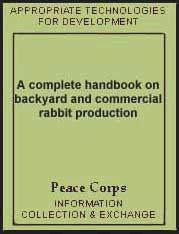
Reproduction[edit | edit source]
Lactation[edit | edit source]
During the last week of pregnancy the mammary glands develop rapidly. Though milk may be produced before kindling, and actually leak from the glands of high-producing does, the actual let-down and production is usually delayed until kindling, and is initiated under hormonal and nervous stimuli induced by the action of suckling. Maximum milk production is usually reached by the third week, after which production gradually declines. The duration of lactation varies depending upon diet, number of suckling young, and the length of time the young are left with the doe. Ordinarily, milk production is negligible after the sixth or seventh week, though in well-nourished, high-producing does with a litter of eight or nine, milk production may last for 8 weeks or longer. Milk has been observed in the stomachs of young weaned from the doe at 8 weeks of age, and milk can be secreted from the glands for several days thereafter.
The amount of milk produced depends upon several factors such as breed, strain, diet, and genetic constitution. Various studies of milk production in rabbits indicate that during the height of lactation, milk yield may reach 35 grams per kilogram of live weight. On this basis, a 4½ kilo doe would produce approximately 140 grams (5 ounces) of milk a day.
Contrary to popular belief, the doe does not nurse her young throughout the 24-hour period. Especially for the very young in the nest box, nursing is usually performed during the night or early morning. It may consist of a single feeding of only a few minutes. After the young leave the nest box and are consuming solid food they will try to nurse several times during the day. However, the doe will usually push them aside and restrict their nursing to the night-time. Occasionally does will allow the young to nurse during the day, as most rabbit breeders have observed. Students of animal behavior attribute the nursing habits of the doe to the fact that rabbits in their natural habitat are extensively preyed upon and are rather helpless to defend their young. Therefore, it is advantageous for the doe to stay away from the young as much as possible.
A regular feeding program determines a regular and consistent nursing schedule by the doe. Therefore, if you feed the doe both concentrate and roughage at 5:30 in the morning and 5:30 in the late afternoon, the doe can be expected to nurse her young regularly between 6:00 and 7:00 A.M. and P.M.
Factors that limit conception[edit | edit source]
Among the causes of failure to conceive, or low conception rates, are false pregnancy (pseudopregnancy), age, poor physical condition, sore hocks, injuries, disease, hot weather, nervousness or restlessness due to mixed colony.
Separate does that are to be mated and put each in an individual hutch 18 days before mating. Then they will have passed through any false pregnancy period by mating time. Sometimes the cycle of pseudopregnancy can be broken by abruptly changing the type of roughage and concentrate or by giving no feed at all for 24 hours. Forced mating can also break the cycle of pseudopregnancy if heat signs are present.
Age - Young does may not be sexually mature at the time of service, and old does may have passed their period of usefulness and fail to conceive. Do not attempt the first mating until the does are sexually mature and properly developed; the proper age is 5½-6 months old and weighing at least 2½ kilos.
Does should reproduce satisfactorily as long as they are maintained in good physical condition and can properly nurse their litters. Retain them if younger and better stock is not available for replacements. In commercial herds, does that are properly cared for should produce litters until they are 2 ½ to 3 years old. An occasional individual rabbit may reproduce satisfactorily 4 to 6 years, or longer.
Physical Condition - Rabbits that go "off feed," go into a prolonged or heavy molt, become abnormally fat or thin, or become out of condition for any reason, may have their reproductive powers impaired. The percentage that will conceive will be low, since they may become temporarily sterile. In any backyard or commercial rabbitry, quantity and quality of feed should never be sacrificed for economical factors.
Disease - Never mate rabbits when they show any symptom of disease. Remove such animals from the herd and hold them in quarantine until they recover. Certainly, sickly animals produce inferior offspring.
Extreme Heat - Rabbits have a tendency to become temporarily sterile in extreme temperatures such as (30° - 32°C). It is recommended to breed in the early morning or late afternoon.